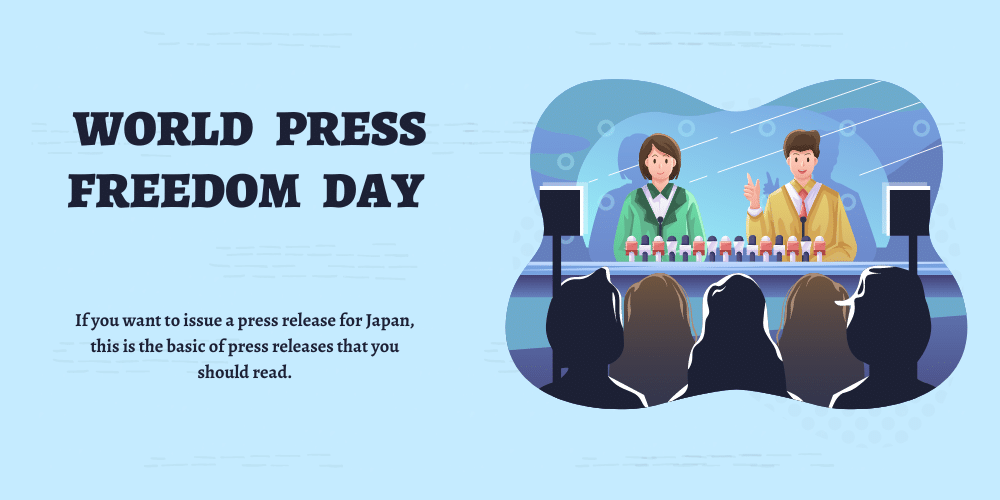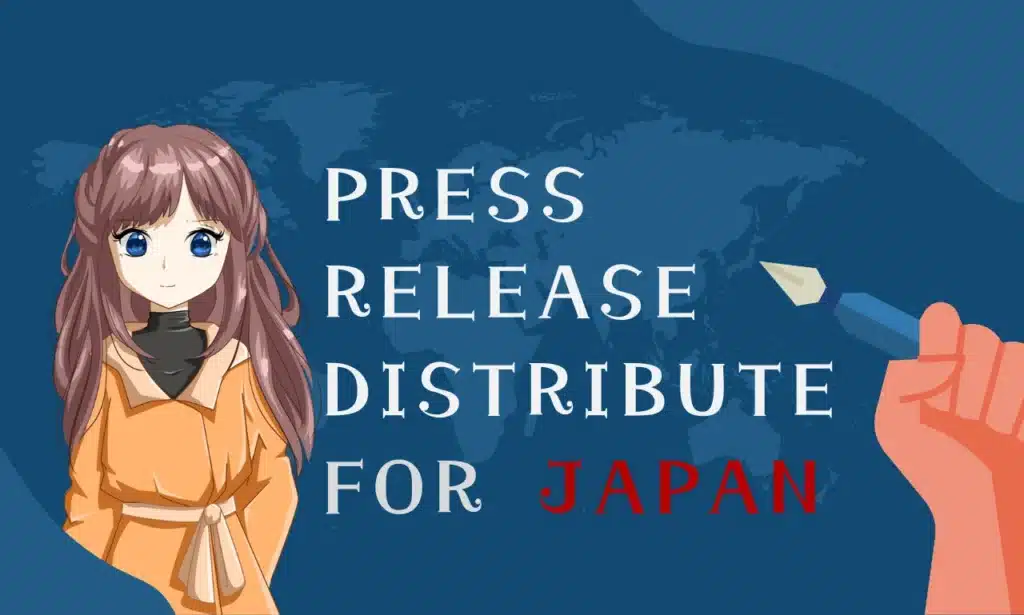Physical Address
304 North Cardinal St.
Dorchester Center, MA 02124
Physical Address
304 North Cardinal St.
Dorchester Center, MA 02124

If you want to issue a press release for Japan, this is the basic of press releases that you should read. If you are planning to release a product or service to the Japanese market and want to announce it in the media, I hope you will take a look at this article first.
If you want to grow your business through media exposure, you have to know how it works. This article summarizes the pitfalls of the services that are out there, how to take advantage of them, and what you really should and should not do.
If you find a service that distributes press releases to Japan, see how successful they are themselves.
There are several press release issuing sites in Japan. When you post your press release on these sites, your press release is sent to the reporters of affiliated media outlets.
Some charge a fee, some are free, but they all work the same way. Even if you pay for the service, you do not get specific contact information for the reporter. It is quicker and more efficient than sending to individual reporters, but you should also know that you will receive a lot of them.
This means that the recipient of your press release will receive a large number of press releases every day. How many spam e-mails do you receive each day? Do you check all of them? Therefore, the most important thing in a press release is to get it opened.
Many press release distribution sites have a system whereby press releases are automatically posted to affiliated media outlets in addition to being posted on the original site. Some of these media outlets are well-known in Japan or have large access.
You can expect some effects if you post your press release on press release distribution sites. In fact, the data on the number of accesses to our press releases show that we receive about 200 to 600 accesses. Press releases can also be linked to your own site, so you can consider it a meaningful search engine measure as well.
The content of your submitted press release may be published as is on the affiliated press release issuing site. Submissions with identical content are not reflected in the search results. Although your press release may temporarily appear in the search results, it is unlikely that the content of your press release will be seen by many people. Also, since the affiliated media automatically post a large amount of information, it is unlikely to appear on the top pages of those media.
Google’s statement makes it clear that links on press release sites and other sites do not count as links. Also, even on press release sites and news sites, external links will have the nofollow attribute set and will not be evaluated as links. Issuing press releases is not a meaningful SEO strategy. Please keep in mind that, based on the above, using a press release distribution site has a certain effect, but it may be almost the same as not issuing a press release at all.
Generally, when a company issues a press release and it is published as an article, it is through the hands of a reporter and is published on the web or in print media.
Since the content is in the hands of a reporter, it is not identical and contains a unique point of view. The content is disseminated according to the characteristics of the media and is of interest to readers and viewers.
Ideally, from the distributor’s point of view, press releases should be sent once and published immediately. How much does a typical small or medium-sized business spend on media relations?
Even for a fairly small unit, if there is no in-house expert, the cost to pay an external party for media measures is 300,000 yen ($2,000) per month, and one or two in-house staff members. The monthly cost is about 500,000-1,000,000 yen ($3,333-6,666.) Even so, the media will only publish the article once every few times.
If we have the budget, we hold a press conference or media presentation. In this case, however, you need to have a list of names for the media or hire a promotion company that can collect them with a list of names.
However, there are low-cost ways to do this without such expenses.
The method I recommend is to get media exposure with as little expense as possible.
Japan boasts a unique culture, and this is no different in the field of public relations. Press releases also have their own unique style, and if you do not follow this format, you will be considered an amateur. No matter how wonderful a product may be, it is not acceptable to introduce a product from a company that has some cause for concern when introducing it in your own media. Therefore, press releases must always be rewritten in a Japanese style format and wording.
The most important thing to be careful about in a press release for Japan is the way it is worded. Japanese people very much dislike overly exaggerated expressions in foreign press releases. They may also think the expressions are very uncomfortable and often do not understand the meaning.
However, in a press release you have to communicate your product in a better and more attractive way. A friend of mine was a reporter at a major newspaper and taught me how to send out press releases from scratch, but at first he said I was too modest.
In other words, if you don’t use an expression that is somewhere between too exaggerated and too modest, it won’t resonate with reporters at first.
In most cases, they will not be able to write the article the first time. No matter how hard you look for better marketers online, this will be difficult. But it doesn’t mean they don’t watch it at all. Many reporters, if they are sent to us all the time, will often think, “I’ll put it in once in a while,” and they will. So you need to send it to them on a somewhat regular basis to burn it into their brains.
In fact, there are times when reporters have nothing to write about because they don’t have a story. This is all about timing, and there is nothing we can do about it. These are times of great opportunity. We want to keep sending them out so that they can be picked up when the opportunity arises.
Many reporters also see press releases in their e-mail.
The title is the only thing that will make them open any of the large number of press releases sent to them. Everything else goes straight to the trash. In general, the titles that are not read or disliked are
The content we are judging is newsworthy or not.
We are looking for newsworthy content. If it is related to what is currently trending or in the news, it is more likely to be opened.
Because of the high public relations element, many people end up writing calls to action and copywriting. ‘If it’s an ad, pay for the ad!’ It is thought to be a good idea. It is better to write from the perspective that your product or service is useful to society.
Depending on the type of media, it is mostly important that the content is socially relevant. If it is something that is currently a hot topic in Japan, an incident, or a related product or service, it is more likely to be picked up.
When a company is small, it tends to escape into abstract expressions. This is because if the company is number one in market share, it is probably a very large company. Otherwise, you would want to say that the quality of the product is high. They won’t immediately believe you when you say “best product.” We get a lot of releases that say the same thing. Therefore, I think it is a good idea to be honest and write specific numbers.
For example, instead of saying “the best product,” you need to use the phrase “95% said it was good.”
It is a good idea to bring it into a form that is easy for the reporter to visualize. If it is an event, it is easier to understand if you include the name of the venue or the place where it is held, or if it is a product, the place of production.
The title alone should give an image without having to read the main text. There is a technique of making the title vague because you want people to read the main text, but this is counterproductive because this is not a blog or news article that you read for pleasure.
Also, the title field has the number of characters indicated. In Japanese, one line can only display about 30 characters. If it is an e-mail, it should be written so that the approximate content can be understood within 15 characters.
Incidentally, the most read news site in Japan is Yahoo! News, where the title is supposed to be 13 characters long. It takes a lot of skill to cram it into this length.
Press release distribution sites are useful, but to be serious, it is better to send them directly. In Japan, there is a media room called a press club. We have been told directly by active newspaper reporters that we can deliver them to these places. We receive a large number of press releases here as well, but there should be less competition than with news release distribution sites!
Japanese newspapers are among the largest in the world, with 8 million copies of the Yomiuri newspaper published daily. They have coverage offices throughout the country and abroad, and many departments at their headquarters. We are also engaged in various businesses. Although there are not many pages in a daily newspaper, each paper has its own department in charge, and sending directly to these departments makes it easier to be featured.
TV stations also have key stations in Tokyo that produce programs. Local stations also produce news and variety programs. These are also huge organizations, but they also have production companies and researchers working for them. Unlike newspaper companies, there are many outside companies, and even for the same program, the company in charge often differs from week to week. For TV stations, it is better to send directly to the program than to the bureau or department.
In Japan, there are a wide variety of magazines and trade journals, as well as trade journals in the style of newspapers. Specialty magazines have a small circulation, but they remain strong and are subscribed to by specialists, so there is a good response when they are covered.
Looking forward to working with you!

Or check Upwork